We independently evaluate all recommended products and services. Any products or services put forward appear in no particular order. If you click on links we provide, we may receive compensation.

Knafs Lander
Quality/Performance - 77%
Value for Money - 79%
78%
- Pros: Easily pocketable, useful blade shape, quick-swap scales with open source to DIY, no-questions warranty support, well designed by a likable guy.
- Cons: Some build quality issues, they could have spent a little more time on the factory edge.
“What iiiiiiiis UP guys?” If you’ve been into knives and the unique culture that surrounds them on the internet, that phrase probably elicits a Pavlovian response in your head – assuming you’re a fan of YouTube knife videos. Ben Peterson was the face of BladeHQ’s YouTube channel from 2011 until 2013, then had a stint at CRKT from 2013-2016 creating digital content, before bouncing back to BladeHQ from 2016 until 2019 when he left. Over that time, he grew BladeHQ’s YouTube presence to an absolute monolith in the category, largely on the back of his extremely popular Knife Banter series that he participated in for 75 episodes. His iconic greeting still rings in the ears of his fans (and even features on the knife we’ll eventually start discussing, I promise.) BladeHQ has over 700k followers at time of writing, and no small portion of that is due to Ben.
Key Specs: Knafs Lander
As sad as the internet collectively was to see Ben leave BladeHQ, we knew he wasn’t leaving the knife industry as a whole. Ben and his wife Athena started their company Knafs in 2018, selling a distinctive poster, before branching out into other products like a knife roll called the Tool Burrito, a clever piece of kit that includes built-in magnets so you don’t drop screws and parts. Ben also launched a collab with WE Knives in 2020 called the Banter, which we reviewed shortly after it dropped. It then spawned the Civivi Baby Banter and the WE Knife Big Banter, which are all pretty universally loved products. When it came time to launch a knife under his own brand, the result was the Lander you see here. The Lander is made by QSP in China for Knafs- a fact which is written on the Lander’s product page, unusual in this day and age of white label products of dubious origin. I see this is not surprising – Ben seems like a stand-up dude – and a good thing, because the QSP knives we’ve reviewed have impressed with their quality and value in the past.
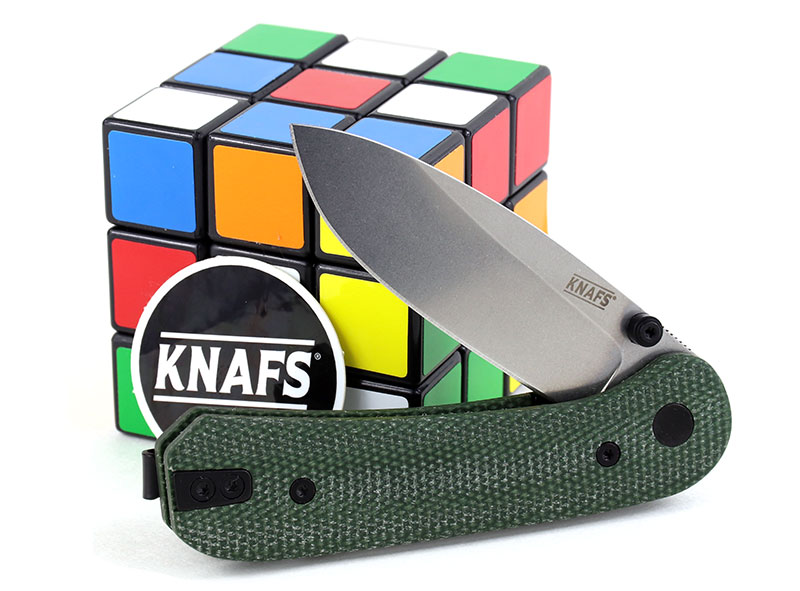
The Lander is named after the moon lander, with Knafs calling it a “knife of possibility.” While the first Lander variants came with G10 scales and a D2 blade, this upscale variant features Allemia (formerly Sandvik) 14c28n steel and linen micarta handles. Like the original Lander, it features fast-swap scales (which we’ll talk about in more detail later) and retails for $79.99. There’s also another, larger variant of the Lander that recently launched with a Clutch Lock that’s OEM’d by Kizer, but that’s a different story. Let’s take a look at the Lander Micarta and dig in to the nitty gritty.
The Blade
The blade on the Lander is a traditional drop point pattern, with a vaguely leaf-shaped profile and a high flat grind. The flats have a diagonal pattern that slopes down toward the rear where it turns abruptly into a vertical plunge line down into the sharpening choil, leaving a short unsharpened portion but no “beard.” Blade stock is thin at 0.1” (0.104” by my calipers) across the spine, maximizing slicing performance with the flat grind. On this model, there’s a deep stonewash finish which helps minimize corrosion, although the Lander is also available with a black stonewash as well. The blade measures 2.75” long with around 2.6” of usable sharpened edge. There’s a very short run of jimping along the spine behind the thumb studs for traction.
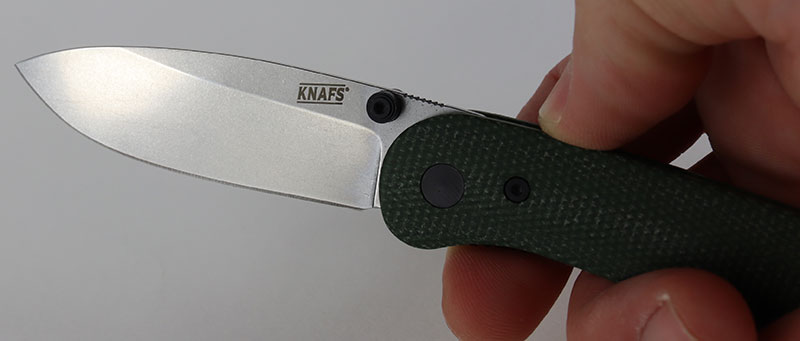
Blade steel is Allemia 14c28n, an upgrade over the G10 handled base model’s D2. 14c28n is an ingot blank steel that was developed in collaboration with Kershaw to make a basic cutlery steel with good performance that can be fine-blanked – cut out with minimal prep work needed, basically. It’s not a crazy super steel or anything, with relatively low carbon (0.62%) but 14% chromium for corrosion resistance and the addition of 0.11% nitrogen (which makes for a harder steel after heat treatment) brings the performance of this steel up. In the info available on Knaf’s website, while 14c28n doesn’t perform as well as D2 in CATRA edge retention testing (at 415 vs 500 cuts) it does outperform the older tool steel formula in in toughness (at 30ft-lbs versus 21 for D2, nearly 50% higher) as well as being much more corrosion resistant than D2, which will sometimes stain if you cut acidic food with it. It’s also a very easy steel to achieve and maintain a sharp edge on. For an $80 price point, lots of products are using 14c28n or other similar performing steels like 154CM or VG-10, so it’s not an issue here.
Deployment & Lockup
The Lander uses thumb studs for deployment, aided by a set of caged ceramic ball bearings in the pivot, and has an external stop pin anchored to the liners to locate the blade in the open and closed positions. Lockup is via a traditional liner lock mechanism that’s nested in the scales.
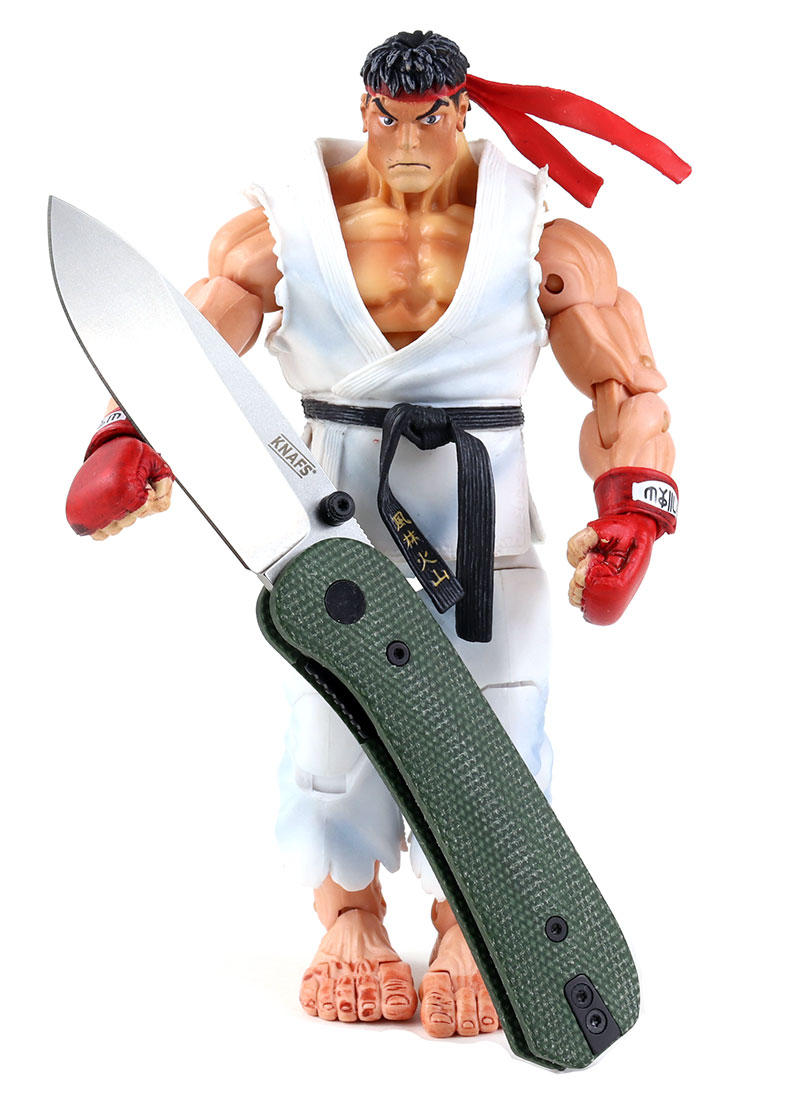
Ben has always been a fan of fidget-friendly knives, and that comes across in the excellent action present on the Lander we tested. The thumb studs are positioned very close to the scales but they stand slightly proud of the surface, so no access ramp is needed, and a light outward and upward flick with your thumb is all it takes to reliably pop the blade open. It seems like a lot of budget knives have started to gravitate towards crossbar locks or button locks lately (and they have their own benefits, namely safety – your finger never crosses the path of travel of the blade) but one thing they miss out on is a good solid detent, which is paramount to achieving a good action.

The detent here is great, firm with a slight “stick” to it when it closes that helps you build up tension to open the knife correctly without having to think about it – muscle memory after a while. Of course, the prevalence of ceramic bearings in a lot of affordable knives in the last ten years has really brought the supreme action of expensive knives into everyone’s pockets, because a knife with phosphor-bronze washers is never going to be this smooth. Still, the satisfying thwack when this knife opens never gets old.
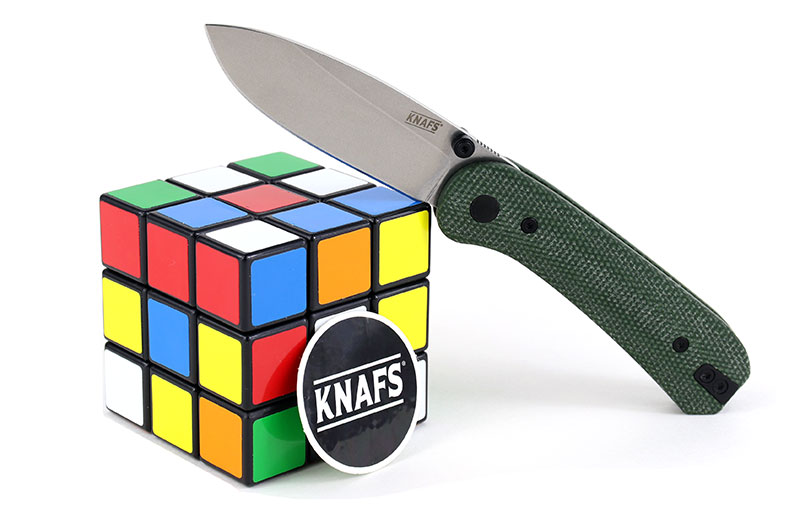
Lockup is great, too – no vertical or horizontal blade play when open, and no lock stick to speak of either. It seems like a lot of the issues that plagued budget knives in years past have largely been engineered out of existence, leaving us very little to complain about. While a crossbar lock is more fidget-friendly, the good old liner locks still works great, and if you want the extra fidget factor, Knafs is happy to sell you a Lander 2.
Features, Fit & Finish
The big draw to the Lander, features-wise, are the quick swap scales. Knafs has designed the knife such that you can remove and swap the scales without disassembling the whole knife – remove the clip, blanking plate, and the two T6 screws holding each scale in place, remove and replace without ever taking the frame of the knife apart. This makes customization easier without having to deal with disassembling and reassembling the frame. I will say, considering the knife is a liner lock with caged bearings, fully disassembling it isn’t going to be a huge ordeal – but it’s a nice touch, and even more valuable on the Lander 2 with the complex clutch lock mechanism.
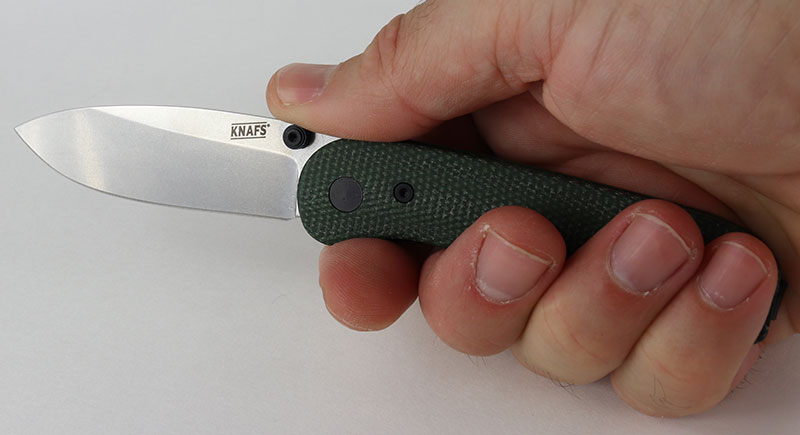
Since the knife is designed to be worked on, Knafs won’t void the warranty for disassembly. They’ve also made the STP file for the scales (a type of file that stores data for a 2D or 3D object, usually for 3D printing in CAD) open-source under Creative Commons License Attribution 4.0, meaning anyone can download the file and create their own version of these scales as long as they link the files back to Knafs. Also, if you mess something up, you can order a Lander Replacement Parts kit that includes everything (every screw, the standoffs, clip, blanking plate, bearings, pivot, and stop pin) for $14. Knafs also sells a ton of interesting scales for the Lander, ranging from flat jade G10 for $20 up to Ultem ($85), GITD Kirinite ($75), Mexican blanket G-Carta ($75), and bias carbon with slots for a toothpick and tweezers a la Victorinox for $58. Other standouts include the infamous Space Kitty, 3D Mars and Moon surfaces, and even a rainbow trout.
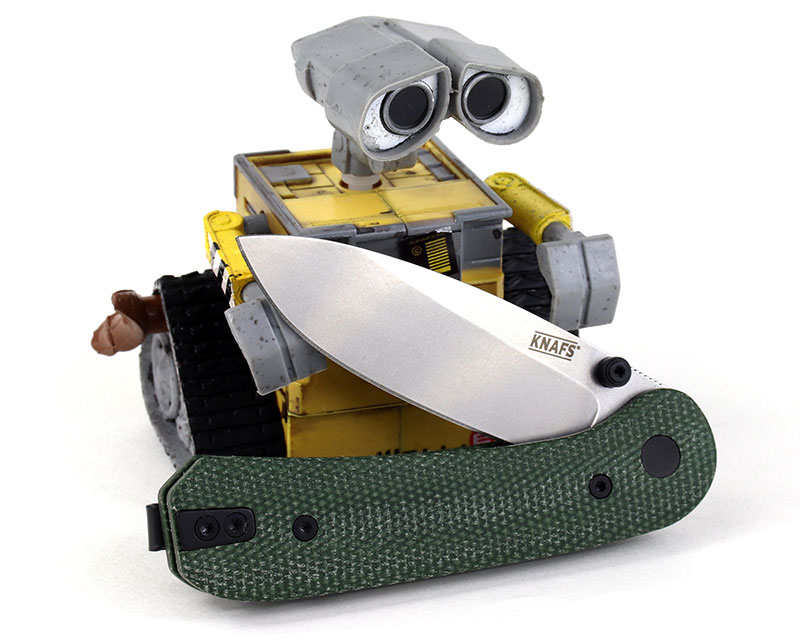
Back to the knife itself, we can describe it as basic but nice. The micarta scales are nicely contoured, and always make any knife feel a little more organic and personal than G10 (at least in my opinion.) They absorb skin oils and dirt over time giving them a natural patina you don’t get with synthetic materials, which is a pro or a con depending on your opinion. The pocket clip is a stamped steel super-deep carry unit, the loop coming over the top of handle and nesting the knife fully in your pocket. A steel blanking plate fills in the mounting hole on the opposite side, and the clip is held in place with two vertical screws with a pass-through hole. The contact point and tip of the clip is pretty deep with a steep angle which may be prone to catching on objects you’re passing by.

Build quality is good but not excellent. One of the scale mounting screws sits slightly above the handles, the factory edge is sharp but slightly toothy and visibly asymmetrical, and the blade sits slightly towards the lock side in the closed position – centering is always an issue with liner lock knives, but it doesn’t rub or scrape. The liners are fully nested and skeletonized on the show-side liner to reduce weight, and the show-side handle is cut further up than the opposite side to give access to the lock bar (along with a small scallop taken out of the inner edge of the handle to create more room.)
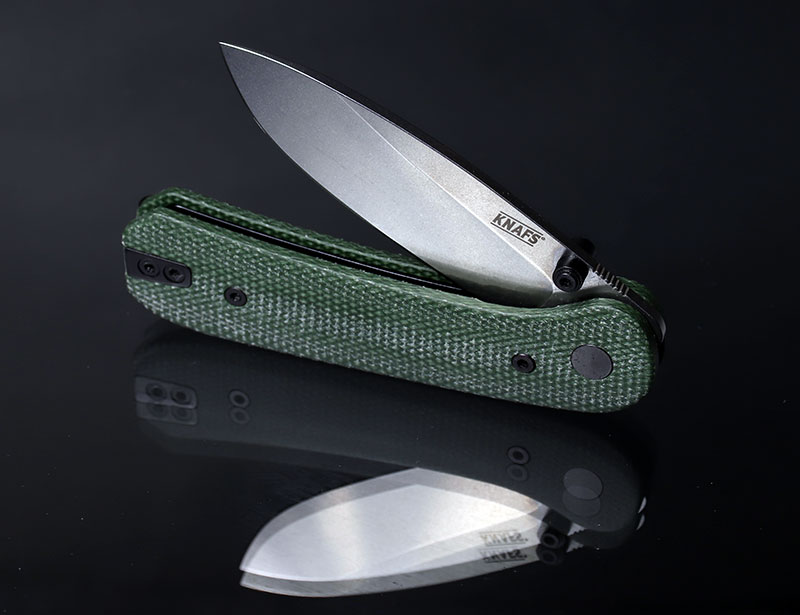
The quick-swap scales necessitate more complex construction. Since the scales bolt to the liners, the liners themselves are attached to the hourglass shaped standoffs with the screws visible once you remove the scales. This means the Lander has a total of 12 body and clip screws, one pivot screw, and two standoffs – a lot of parts to keep track of. It’s important to remember where each screw goes, since the four clip/blanking plate screws have an angled shoulder, the 4 scale to liner screws have a square shoulder, and the 4 liner to standoff screws have a square shoulder and medium-yield Loctite. On the plus side, the pivot barrel is keyed to the liner to prevent it from rotating when you tighten or loosen the pivot screw, and the stop pin is just press-fit into the liners.
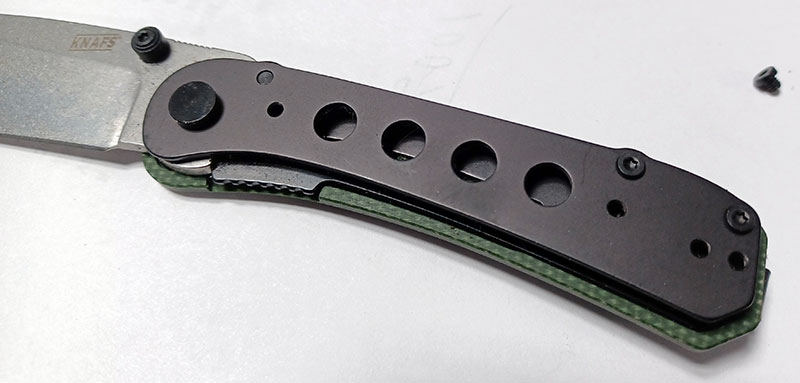
Branding is minimal, with the angled Knafs logo on the show side in front of the thumb stud, while the lock side features a diamond with the acronym “WIUG” (you know what it means!) and the model name and steel type etched below. No branding is present on the pocket clip, which is good when you don’t want people to know what you’re carrying.
Field Test
The Lander weighs in at 2.4 ounces with a closed length of 3.6” and the handles measure 0.4” wide, so pocket real estate is largely unencumbered by this knife. Anything under 3 ounces is light enough to me to not matter, and while the pocket clip might be a bit of a paint scraper, it’s excellent going in and out of the pocket, with a smooth ingress and nice tension when in place. The lack of a flipper or other protrusions also means you’re not likely to snag your hand on anything when you reach past it. Carry is excellent.
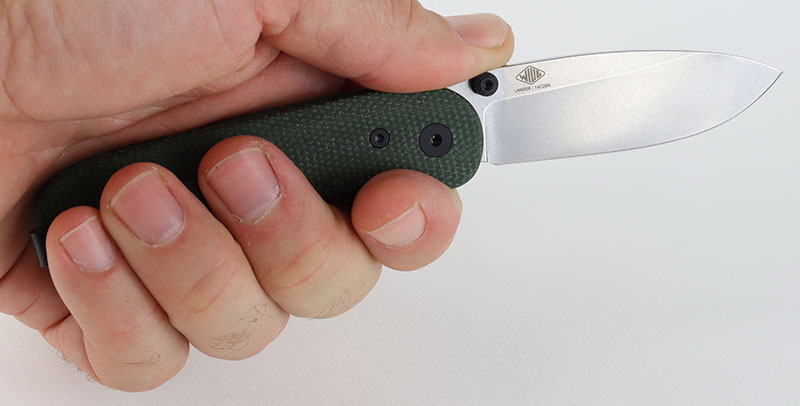
The mid-sized nature of the knife (2.74” blade, 6.4” overall) is the sweet spot for EDC knives for me. The handles are just long enough for a full four-finger grip in the hand. There’s no crazy design going on with these handles, with a straight spine and a gently curved underbelly that fills your palm nicely, and that short run of jimping on the spine is all you need for a secure grip. There’s not much of a finger guard or any forward finger choil, which would probably be wasted real estate in a knife this size, but it feels great in the hand especially with these curved micarta scales.
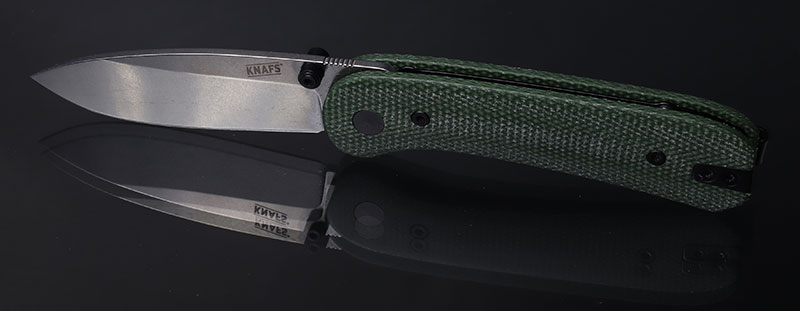
Ben’s designs are simple and unpretentious, kind of like the guy himself, and this translates into a nice working knife – a design that works with you, not one you must work around, which can be an irritation on some more outlandish knives. I particularly like the blade shape, with a pronounced belly for roll cuts and a nice acute tip that’s great at piercing material, while the diagonal plunge line leaves plenty of material behind the tip for strength. The drop point blade shape is a great all-around design, being adept at breaking down boxes, opening up packing, popping off zip ties, and the other day-to-day tasks you’ll typically come across.
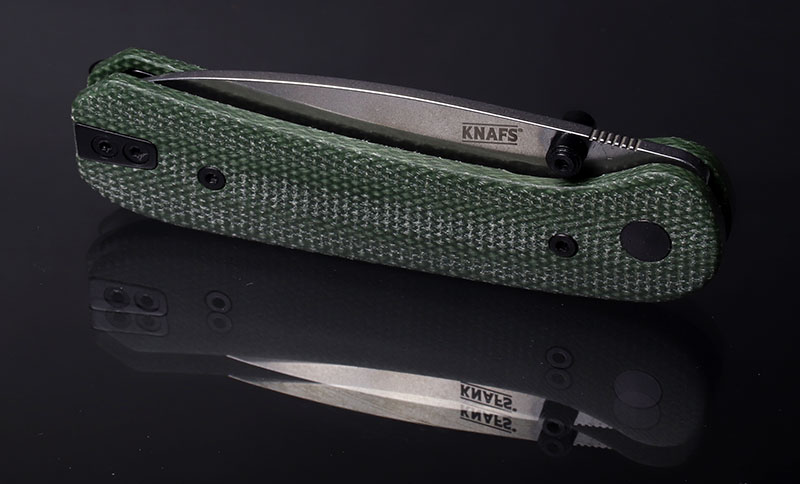
Disassembly and maintenance are easy, with flow-through construction allowing you to blow the knife out with compressed air, and just standard Torx fittings for maintenance. The blade shape and steel type make resharpening a cinch (which is referenced on the product page as well).
Alternatives
All these knives available at BladeHQ.
At $80 retail, there is no shortage of competition for the Lander. We’re looking at knives under a 3” blade with a drop point blade shape, sub-$100 price tag and sub-3 ounce weight for the comparative set, which leaves us with lots of potential options.The Lander itself falls right in between Ben’s previous folder design, the Banter (by WE Knives) and the Baby Banter (by Civivi) both in price and size. The Civivi Baby Banter costs $59 in standard form, with the choice of multiple color G10 handles or $61 for Micarta. It has a 2.4” drop point blade in Nitro-V steel, with a forward finger choil that brings the useful edge length down to 1.95”. It’s lighter at 2.0 ounces, but only measures 5.46” overall so it might be a three-finger knife for people with big hands. The regular sized G10 Banter has been discontinued, leaving the Micarta Banter at $110 the main option. It has a larger 2.9” drop point blade in high-end CPM S35VN powder metallurgy steel, a 6.52” overall length, and a weight of 2.0 ounces.

One of the most popular knives in this price range is the Civivi Elementum, which we reviewed when it was still fresh a few years ago. The success of the Elementum has caused the brand to expand the lineup considerably in the last few years. The original, with its flat G10 scales, flipper deployment and liner lock, runs a solid $50. It has a 2.96” long drop point blade in D2 steel, flipper deployment via ball bearings, and is capable and well-made if lacking in character. The Elementum II upgrades to a button lock and Nitro-V steel for $65 and is available in a variety of handle materials including Ultem. The Elementums are light (3.12 ounces for the button lock, 2.89 for the liner lock), well made, simple knives – but the Lander feels better in the hand and has a little more personality.

For around $70, the Kizer Original is one of the best all-around EDC knives in the game. Featuring thumb stud deployment with a button lock, a 3” drop point with a full flat grind in 154CM, and aluminum or G10 scales, the Original pares your EDC down to the essentials, with excellent built quality and action, a thin profile, and light weight – the G10 variant is only 2.2 ounces, while the anodized aluminum version is 2.6. The Original isn’t fancy but it’s one of my all-time favorite Kizer products, especially the Sarape G10 version with its Mexican blanket-themed handles.

Finally, another worth considering that brackets this price point is the Spyderco Persistence Lightweight. Available in two versions – a regular variant with 8Cr13MoV steel for $48, or an upgraded one with CPM S35VN for $103, the Persistence is part of Spyderco’s value lineup of folders. These Chinese-built knives, best known for the Tenacious, have expanded in the past few years. The Lightweight Persistence uses bi-directional FRN scales on top of stainless liners, a liner lock, a round thumb hole for deployment, and features a full flat ground 2.75” drop point blade. At 3.3 ounces and 6.81” overall it’s a little heavier than the Lander, but lighter than the G10 version at 3.7. Spydercos are very polarizing – you either love them for their function or hate them for their challenging looks, but they always work well. The Persistence offers a four-position pocket clip, albeit not a deep-carry one, and with that full flat ground satin finish blade it’s sure to be a slicer.

Wrap-Up
I wanted to like the Lander, because we all really like Ben Peterson. Thankfully, he didn’t make it hard to like his first knife launched under his brand, because it’s pretty great. The basic form factor is light, easy to carry, immensely useful, and fidget-worthy to boot. The addition of quick-swap scales, and the thoughtful nature of making the CAD files for the scales open-source, speaks to the positive influence Ben has had on the community during his time. It’s a cool knife, and you can put Space Kitty scales on it, and they don’t care if you disassemble or mess with it – they’ll ship you parts! It’s like the opposite of a Medford! Downsides are few: I think QSP could put a little more love into assembling and sharpening these knives, and the quick swap scales means there are a lot more parts than your average knife. Regardless, it’s still light and robust, so who cares? Have fun with it.





